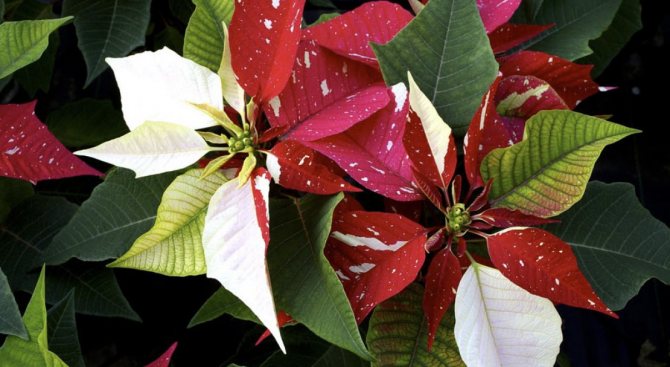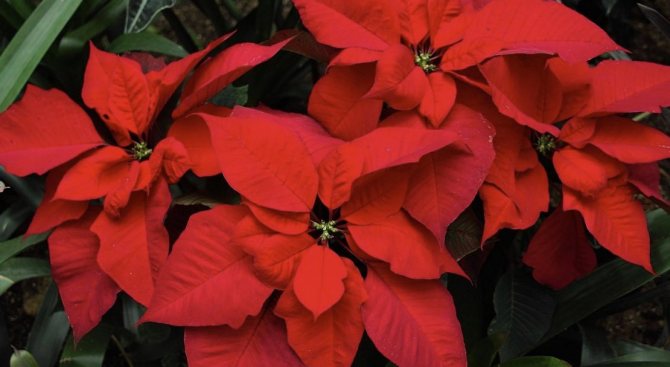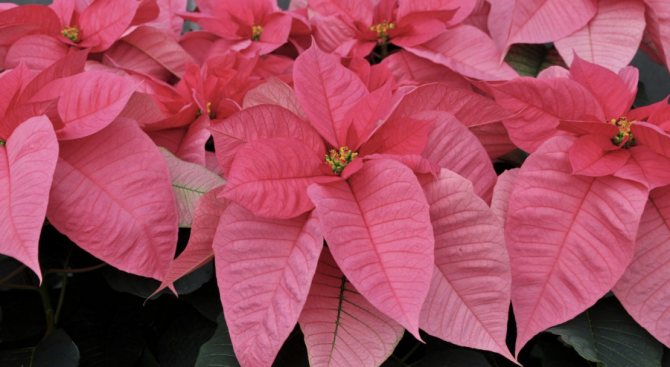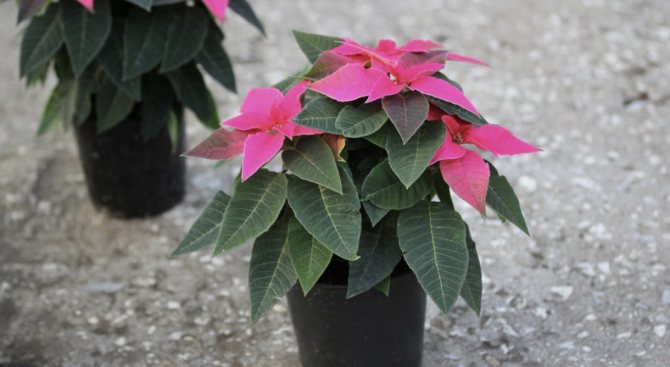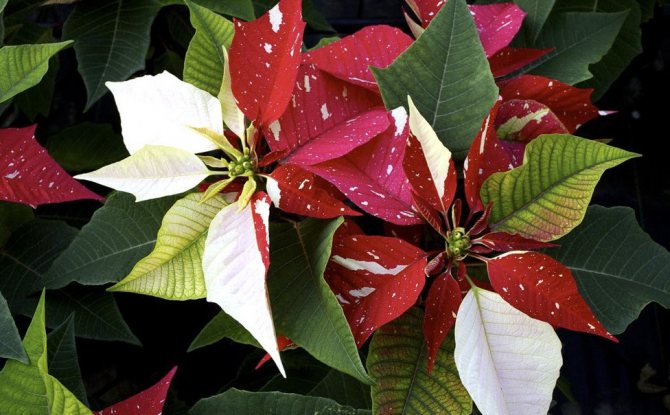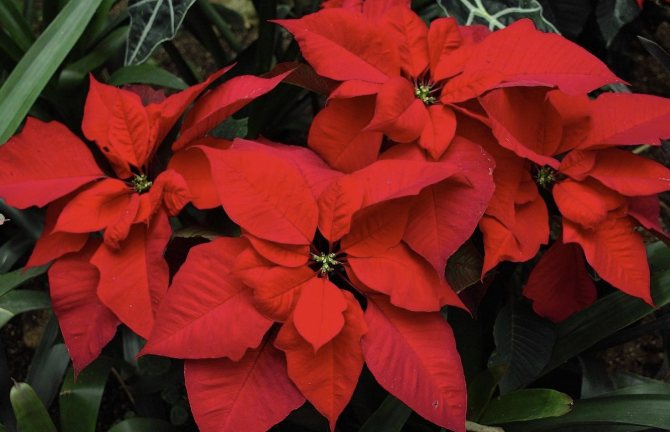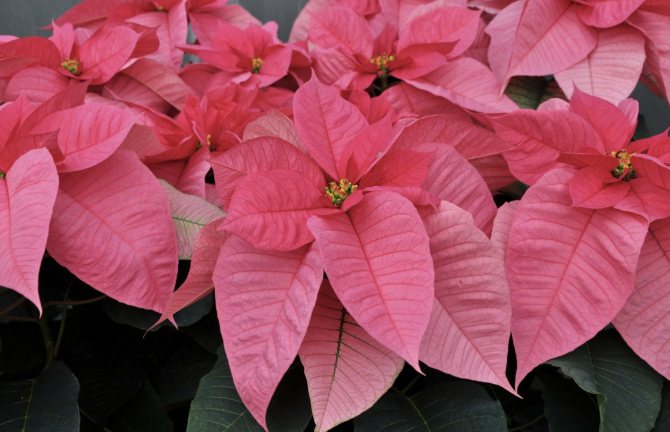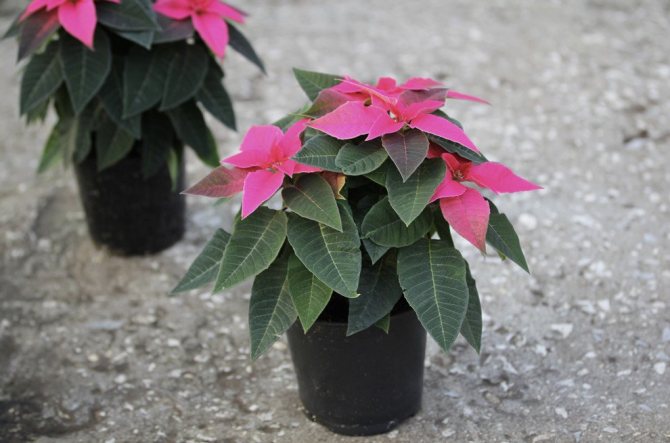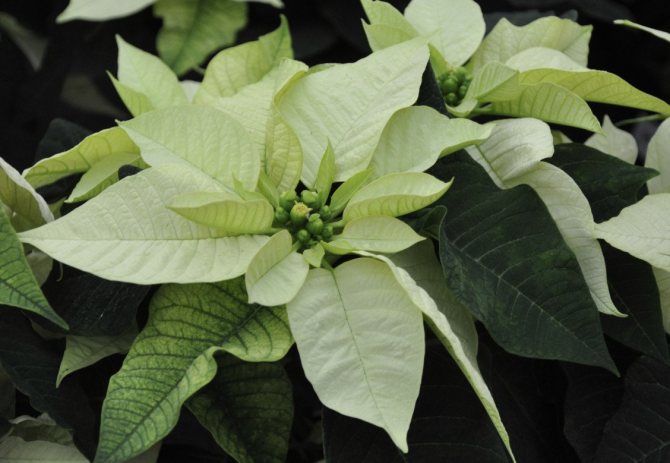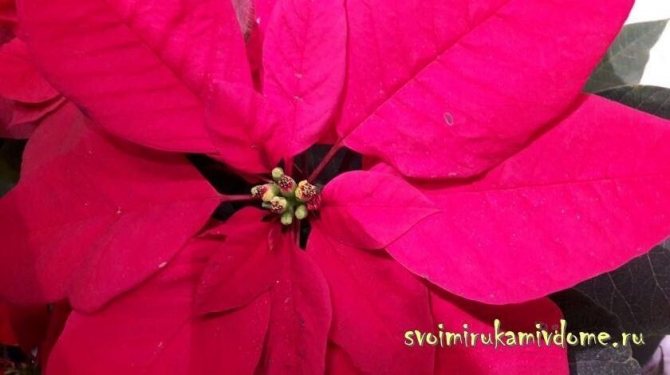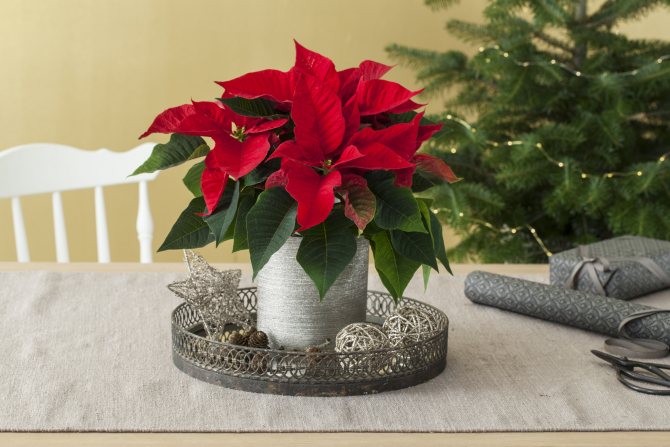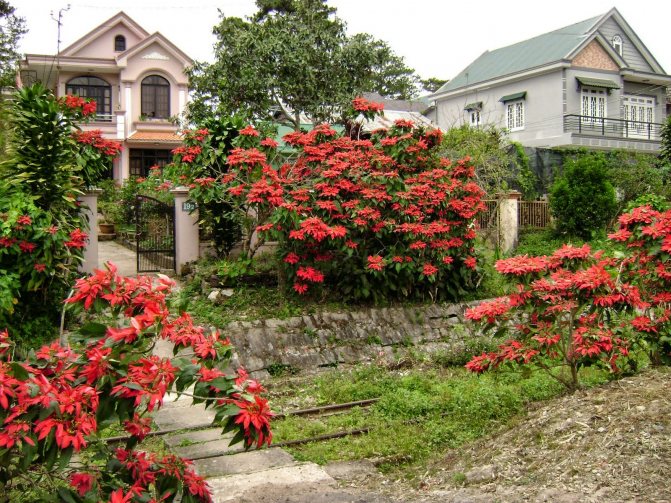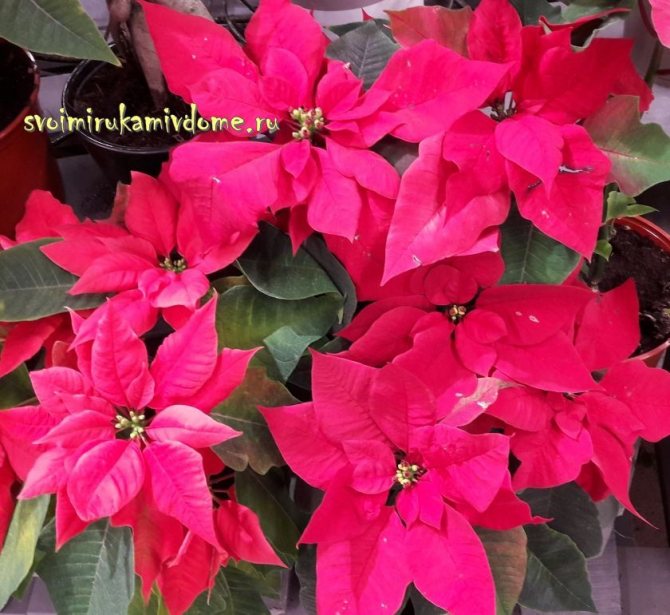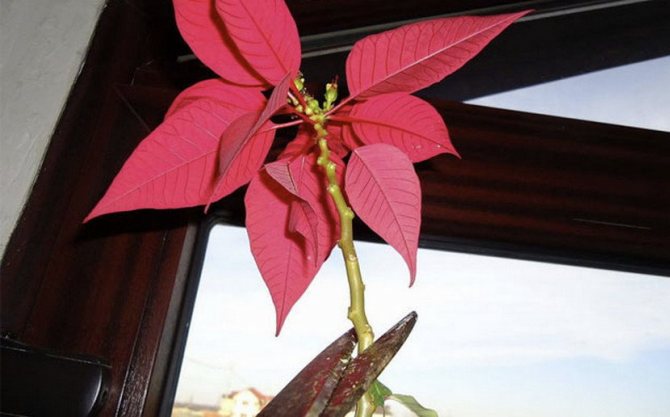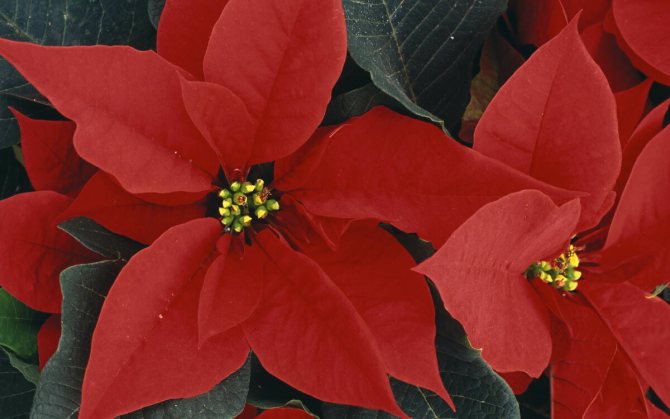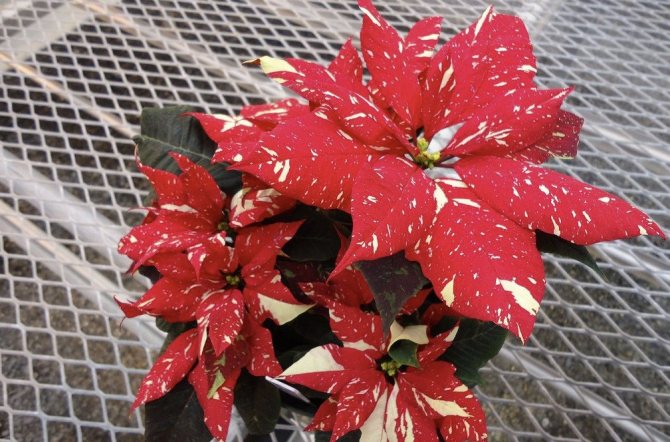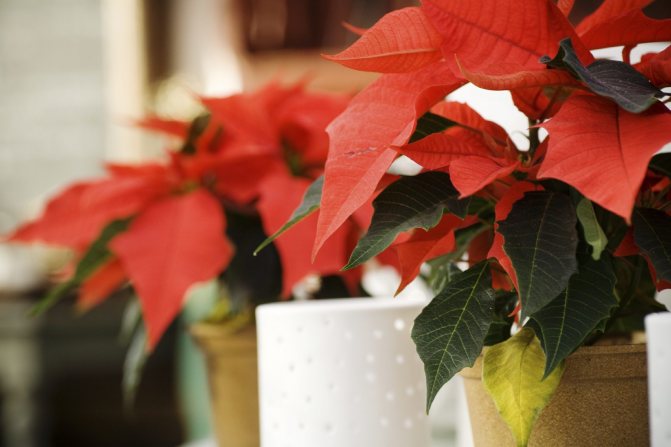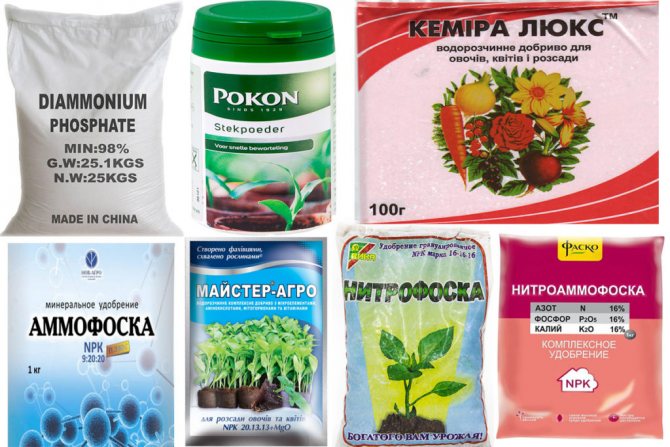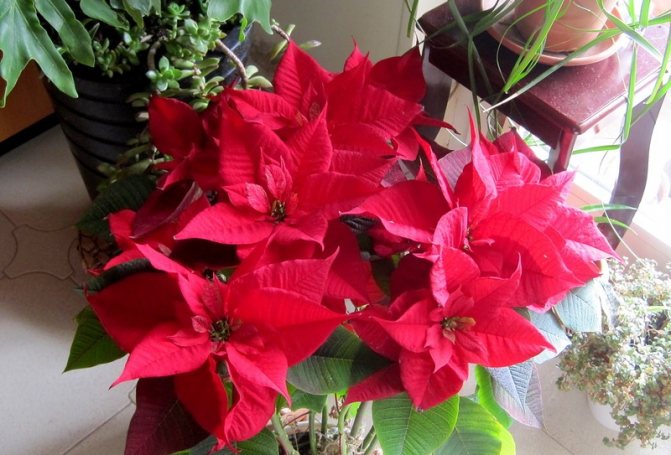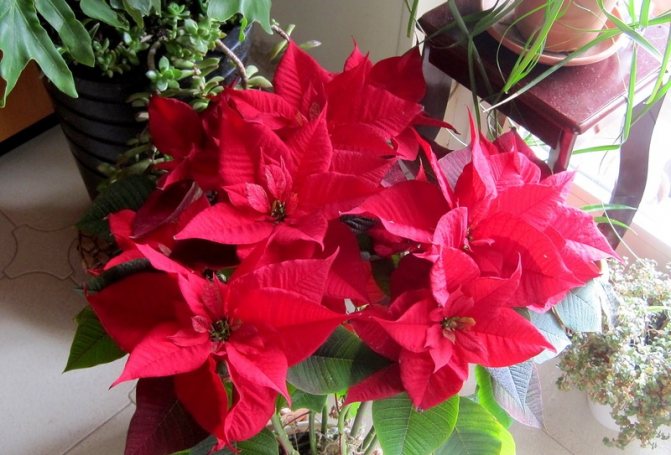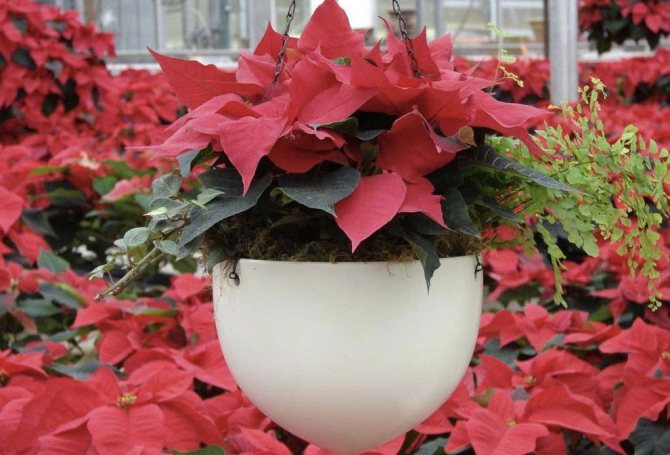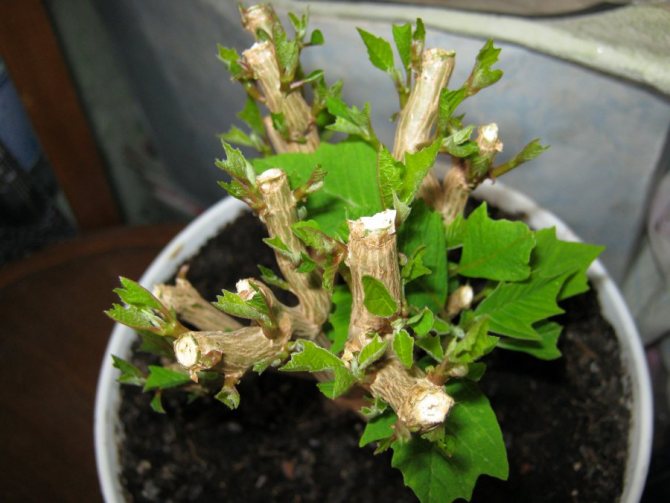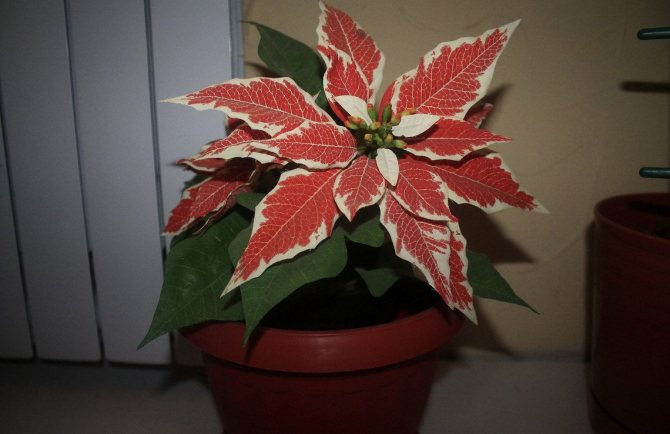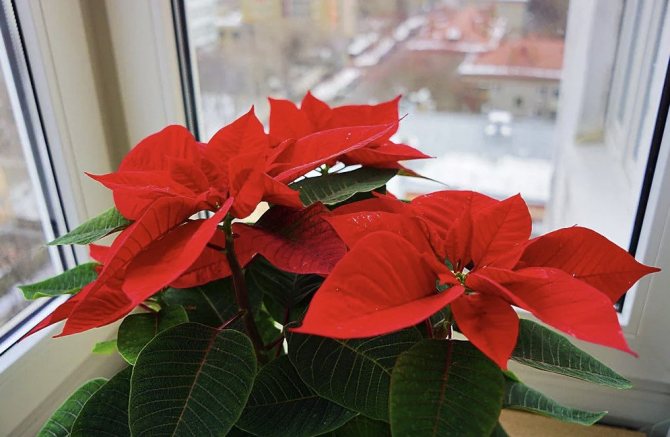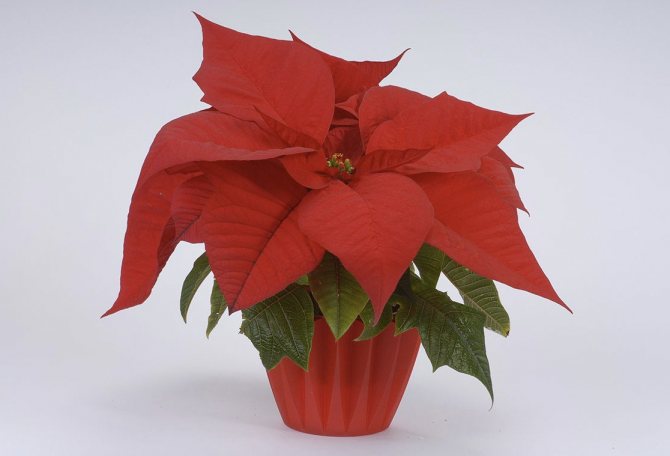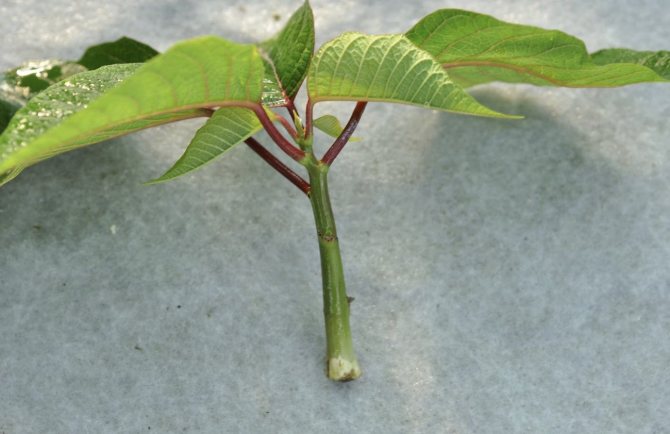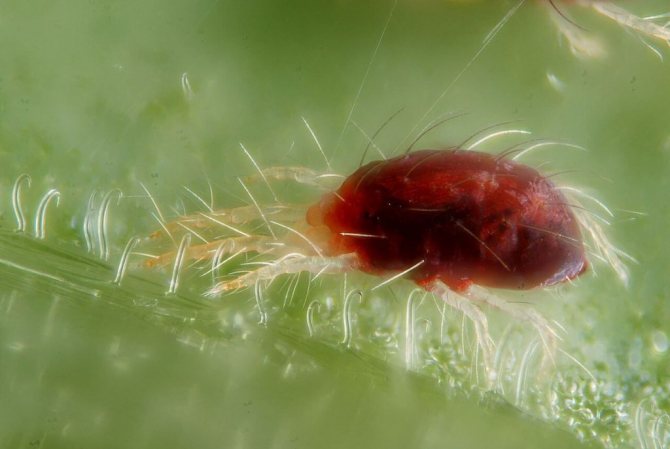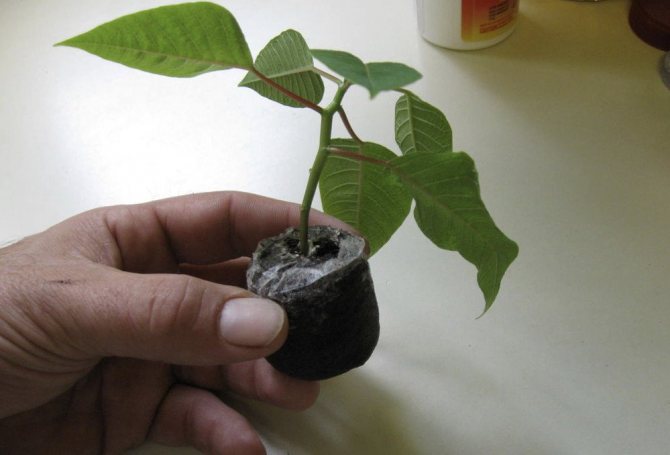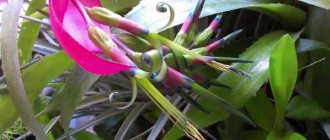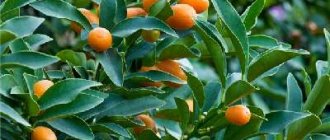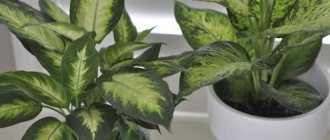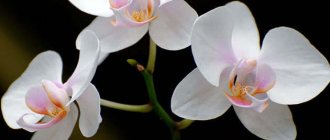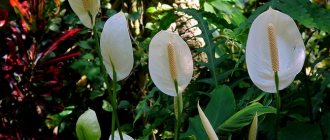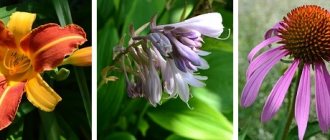Plants that bloom in the coldest and darkest winter months can be counted on one hand. One of these "unique" is the most beautiful poinsettia (Euphorbia is the most beautiful, Christmas star). In winter, it blooms with small flower buttons, framed by bright bracts of red, pink, white tones. They give the plant a festive, recognizably "Christmas" look.
Poinsettia is usually bought on New Year's Eve or Christmas Eve, as a temporary decoration. After flowering ends and the bracts fall off, the plant is disposed of. This happens because poinsettia is very capricious. For many unlucky flower growers, it rots already in the first months of being in the house, for others it never blooms again. The Christmas star needs special care, taking into account its tropical origin, clear periods of rest and growing season. In this case, it will delight you for many years, blooming anew every December. And it can bloom for 3-4 months! Therefore, it is still worth making friends with her and saving, despite the difficulties.
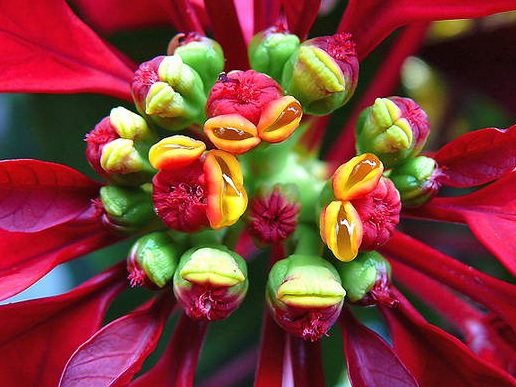
Poinsettia flowers are small, inconspicuous, but they are framed by bright colorful bracts
Plant-related signs
Perhaps the fabulous appearance and flowering around Christmas was the reason for the various positive properties attributed to this plant. It is believed that the indoor poinsettia flower attracts welcome guests to the house and helps its owners in communication. Also, the "Christmas star" protects the house from any negativity and even prevents evil thoughts, neutralizes stress and conflicts.
Another "Christmas flower" helps its owners to develop hidden talents in themselves, to form leadership qualities. And even promotes weight loss and rejuvenation - just by its presence in the house. Therefore, it is not recommended to keep the plant in the bedroom - its stormy, active energy will interfere with a restful sleep.
Photo gallery
Poinsettia blooms in winter with small yellowish flowers, grouped in rosettes. When blooming, bracts of a deep red color are formed around them, giving the plant an unusually decorative look. Now varieties have been bred with pink, cream, white and two-tone colors.
The plant sets three-lobed fruits, which contain three one-seeded nuts.
Did you know? Poinsettia has other names - euphorbia the most beautiful, Christmas star, euphorbia pulcherrim, star of Bethlehem. Named after Joel Poinsett, the American minister and ambassador to Mexico, who brought this Mexican plant to the United States and grew it in a greenhouse.
Poinsettia plant species
Classic poinsettia Red has bright red percolored leaves. The flowers themselves are modest, yellow. The leaves are the traditional juicy green.
Poinsettia name Bordova speaks for itself. Its lush perianth is of a bright burgundy color. The flower grows to a height of 25 cm.
Poinsettia Variegata possesses a pink or burgundy perianth. It differs from other representatives in white specks on colored leaves.
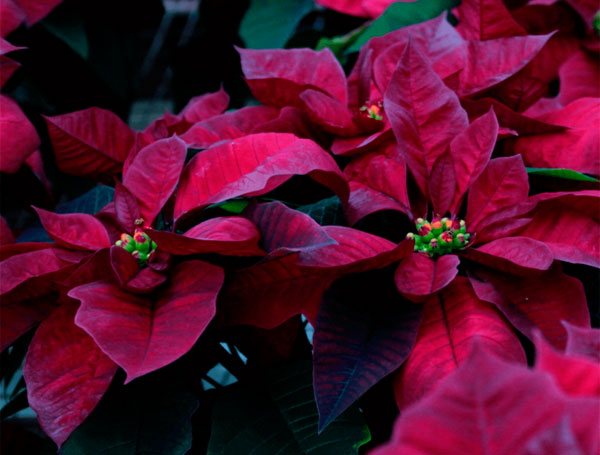

Poinsettia varieties Cortez Are short but very bushy varieties with white, yellow, cream or pink bracts.Sonora White also has white perianths, but these are marked with an ivory tint.
There are special varieties that are very different from the classic milkweed of the finest. This is, for example, the Marble stargazer with the marbled color of the bracts, or the Winter rose with very large and dense bracts, curved like roses. Creamy strawberries have pink-purple bracts with curly white edges.
New varieties appear regularly, striking fans of this flower with their exquisite and catchy variety.
Home flower poinsettia - Christmas star, description, photo
Poinsettia or Euphorbia pulcherrima of the Euphorbiaceae family is a perennial shrub plant with hollow, straight stems that, when cut, secrete a milky juice, quite poisonous. Leaves broadly lanceolate with carved edges, elongated, bright green. The homeland of plants of the Euphorbia family is Africa and America.
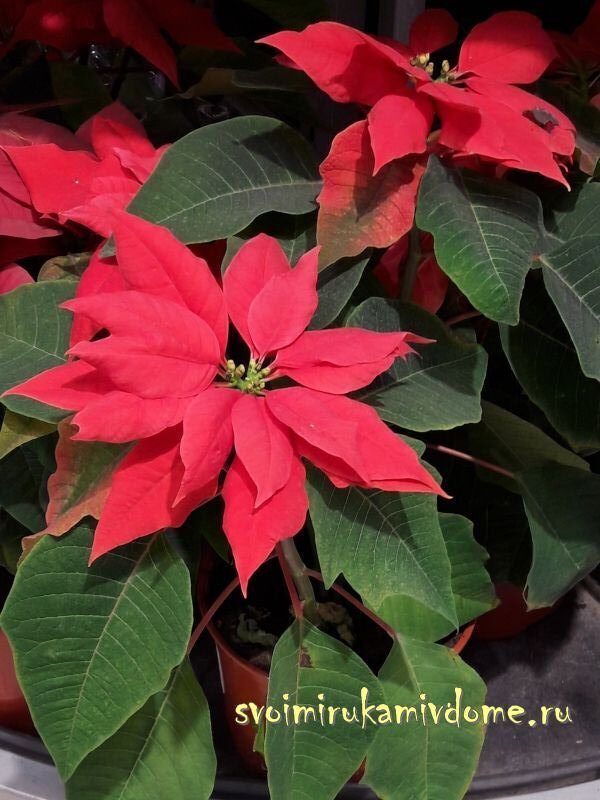

Poinsettias in pots
Poinsettia flowers are small, yellowish, imperceptible among the luxurious bracts - the main decoration of this amazing plant; the wonderful coloration of the bracts pleases the eye in December-January. Different varieties have red, salmon, pink, yellow, white and beige inflower leaves. Even one well-formed perennial plant looks great, and if there are several of them of different sizes and with various colors, the spectacle is simply amazing!
In stores on New Year's Eve, poinsettias of different sizes and colors are sold in pots, with one and several stems, you can even find plants that have been formed over many years on a stem in the form of a small tree.
Recommendations for those looking to buy poinsettia
When choosing a Christmas flower for your home in a store, give preference to plants from Russian greenhouses, rather than those brought from abroad. Local flowers will take root better at home, last longer and produce more viable cuttings.
You can easily find a description of the royal geranium plant and its photo at this address:
In this article we will tell you why indoor geranium does not bloom, and what measures will help to achieve flowering.
And how you can propagate geraniums yourself, read here.
Pay attention to specimens in which most of the flowers have not yet blossomed, but are collected in buds. Such a flower will live longer anyway. But a flower with crumbling flowers is best avoided.
The foliage of the plant should be lush and healthy. Accordingly, the store should be warm, because poinsettia loves moderate temperatures and does not get sick under these conditions, while maintaining its spectacular appearance. For the same reason, ask the seller to wrap your poinsettia in heavy paper so that it does not freeze on the street, and hurry home.
The price of poinsettia fluctuates in a very wide range. You can find a copy for 160 rubles, you can buy a more expensive poinsettia - for 600-700 rubles... Found on the windows of city and virtual stores "Christmas flowers" for 1,500 rubles, 2,000 rubles and 2,500 rubles. On professional websites of florists, you can find luxurious tall and well-developed specimens in pots for 3,800 rubles.
After the purchase, the transplant of the poinsettia is not required, it will not need fertilizer for the first time either. Caring for a poinsettia after purchase is no different from regular caring for it.
Blooming poinsettia
Bright poinsettia flowers are actually colorful bracts, which are surrounded by a bright wreath of real small and inconspicuous, odorless flowers.
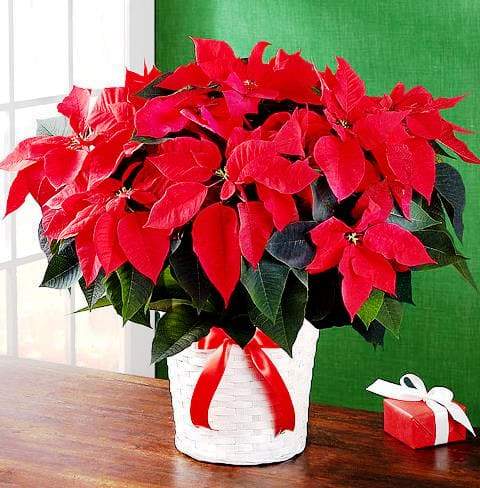

Blooming red poinsettia
In nature, bracts are always red, and varieties can have all shades of pink, white, pale green, cream, apricot, yellow and even lilac.There are two- and three-color variations, as well as varieties with stunning, seemingly double, corrugated bracts.
Venus flytrap at home
When does poinsettia bloom? The transformation of a green plant into a colorful Christmas star only occurs under appropriate growing conditions.
Leaf coloring requires short sunny days and long periods of darkness of at least 12-16 hours daily, so flowering occurs in late autumn and winter. This phenomenon is called photoperiodism.
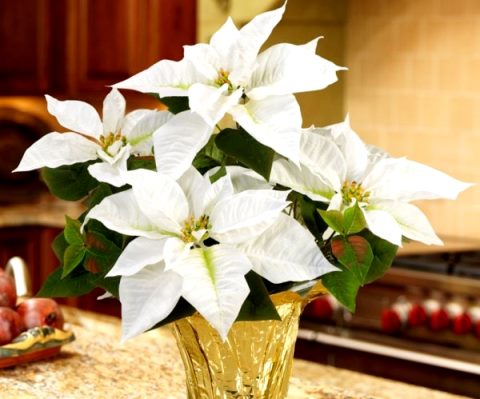

White poinsettia variety "Pure White"
Manufacturers very carefully control this process and after the necessary period, the most beautiful euphorbia appears in stores in all its glory, so that before Christmas everyone can decorate the house with flaming red stars.
More than one hundred million poinsettias are sold annually in Europe, and at the end of December, a flower is sold every second. Flowering after purchase usually lasts 2-4 months.
After flowering with increasing daylight hours, the most beautiful euphorbia loses its bright color of the bracts, which gradually turn green.
How to take care of the poinsettia yourself at home
If you put the poinsettia on the windowsill, make sure that no part of the plant touches the glass in cold weather. Also protect it from harmful drafts and sudden temperature changes.
In summer, poinsettia flowers can be taken outside, but you need to take care of protection from strong winds, direct bright sun and precipitation.
The best option for the care and maintenance of poinsettia is bright, but diffused lighting. After all, direct rays of the sun can destroy the brightness of the bracts. Therefore, it is better to shade the plant. East or west windows are great for poinsettia.
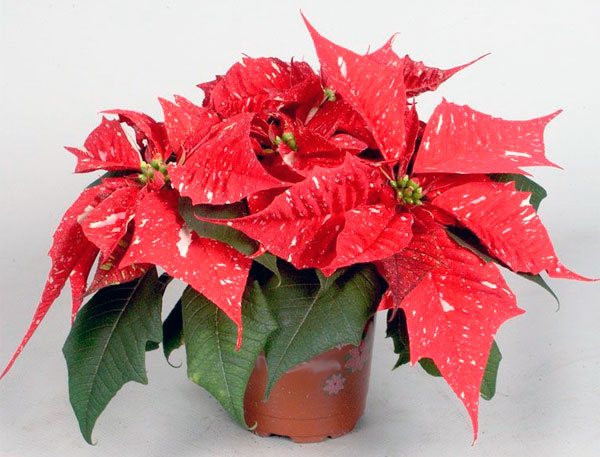

In spring, summer and early autumn, poinsettia is quite satisfied with the usual room heat of 18-25 degrees. But in winter, during the most important flowering period, it is recommended to reduce the indicator to 14-16 degrees. In the resting phase, she prefers even lower temperatures - only 12-14 degrees above zero. The thermometer should not drop to 10 degrees and below.
Moistening the earth is carried out when the topsoil dries out. Watering is required in moderation, without the risk of stagnation of water at the roots - otherwise they will not receive enough air, and this will have an extremely negative effect on it. In addition, long-term and excessive waterlogging threatens root rotto which the poinsettia is predisposed.
When caring for a poinsettia flower at home, high humidity is not required. It will be enough to periodically spray it from a fine spray bottle with soft, settled water. If the air in the room is too dry, spraying can be done more often.
How is the poinsettia care after flowering
It is necessary to trim the poinsettia after flowering when it sheds the bracts. Most often this is the end of January or the beginning of February. At this time, its stems need to be shortened, leaving 10-15 cm above the ground.
Pruning is also carried out during the active period of the plant as needed, too long shoots are cut off. This will help the flower to bush beautifully and not stretch out. The cut shoots can be used as propagation cuttings.
Almost immediately after the bracts fall off and the flowers fade, the euphorbia falls into a dormant period. And at this time (about two months), the plant does not need to be fertilized, in addition to this, watering should be significantly reduced and the temperature should be maintained at 12-14 degrees in a room with a poinsettia.
After a short period of rest, the awakened poinsettia should grow stronger for its new flowering. Therefore, it is recommended to fertilize the flower from spring to autumn. For this purpose, mineral fertilizer complexes are suitable.
How can you transplant a poinsettia yourself
The poinsettia should be transplanted annually in the spring, when the cut stems begin to grow again and the plant enters an active phase (usually April or May). Previously, you have to cut all the stems by a third, leaving 3-5 most developed buds on each.
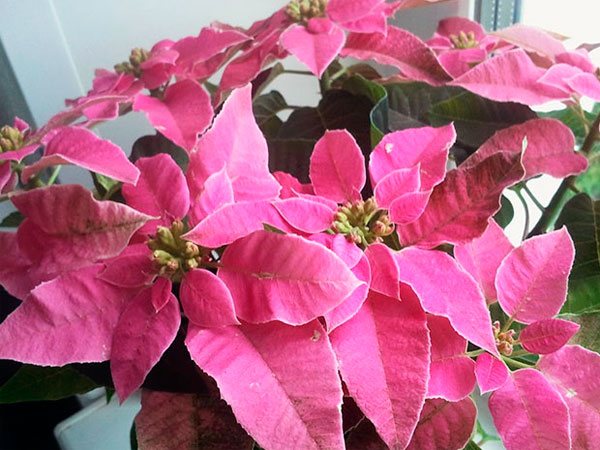

After that, the poinsettia must be placed in a bright and warm room, pouring it with warm water that has had time to settle. Only after the appearance of the first leaves, you can start transshipment plants in a new container. It should be filled with neutral soil and a layer of good drainage. A mixture of leafy soil, sand and dry manure in a 2: 1: 1 ratio is suitable.
After planting, the poinsettia needs warmth, abundant watering and spraying. Of all the new shoots that will appear later, only 5 or 6 of the strongest need to be left, and the rest should be cut off.
Preparing for flowering (late September - November)
In normal indoor conditions, without observing certain maintenance regimes, the flowering of poinsettia can be difficult. In order for the budding to take place, it is necessary to create conditions for the plant that are close to natural. In its homeland, Mexico, poinsettia blooms after 2 months of short daylight hours with a duration of 10 hours. When keeping poinsettia in living rooms, such conditions are provided artificially. There are several options for how to do this:
Option number 1 - protect the poinsettia from light
Beginning in late September, from 6 pm to 8 am, cover the poinsettia with a cardboard box or an opaque plastic bag.
Option number 2 - provide a natural change in darkness and light
In the fall, place the poinsettia in a heated greenhouse or non-living room with no artificial lighting. Naturally short daylight hours during this period will be sufficient for her.
Option # 3 - use light barriers
Unfortunately, in normal room conditions, the poinsettia on the windowsill will be illuminated by electrical appliances: lamps, TV screens, etc. Even a small amount of light that goes beyond the norms of short daylight hours can "knock down" the blooming of a Christmas star. If you decide to make your poinsettia bloom on the windowsill, then use blackout curtains as a screen from home light. After 6 pm, pull them tightly so that the poinsettia on the windowsill is in the dark.
All this time:
- water the poinsettia with warm, settled water after the soil dries out in half the pot;
- apply fertilizers for decorative flowering once a week.
At the end of November, after 2 months of short daylight hours, all manipulations can be stopped and the poinsettia can be placed on a light, warm windowsill. Very soon, buds will appear on it, followed by colorful bracts.
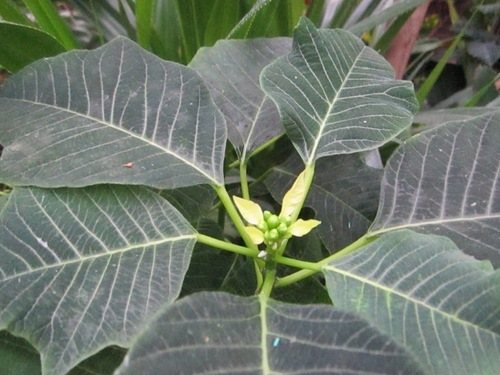

The beginning of flowering poinsettia: buds and colored bracts appear on the apical cuttings
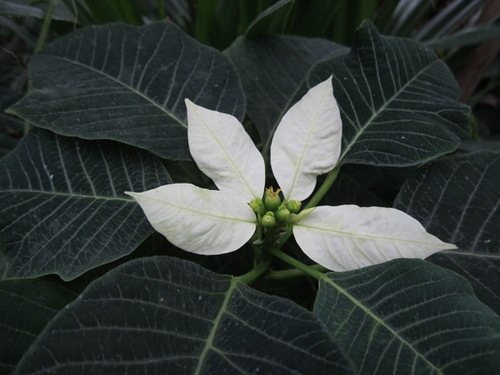

Gradually, the bracts become larger, the flower buds open
Why is your poinsettia not blooming?
If done correctly, the Christmas star will bloom on its own, no additional effort is required. Proper watering, correct lighting and temperature will guarantee success.
If the plant does not bloom, it means that it does not like one of the listed items - try a different watering scheme, move the flower to another place.
The task of achieving re-flowering is much more difficult. In this case, you will have to create certain conditions for the flower. When he begins to fall of leaves, you need to greatly reduce watering and stop fertilizing. In early April, all poinsettia stems should be trimmed 15 cm above the soil to encourage vigorous growth.
Lighting should be good, watering should be regular, you can start fertilizing with mineral dressings.As soon as the stems begin to grow, transplant the flower into new, fresh soil. Its optimal composition: 2 parts of leaf humus, 1 part of sand and 1 part of dry manure.
Further, from the beginning of October, every night, place the poinsettia in absolute darkness for 14 hours: for example, put it in a large box or a spacious closet at night. In the afternoon, return to the usual place. And so - 8 weeks. All this is necessary in order to somewhat slow down the growth of foliage and direct the forces of the plant to the formation of flowers. When the bracts become noticeable (as a rule, this happens after 2-3 weeks of such a regime), you can resume the usual care for the plant.
Transfer
After adaptation, the flower must be transplanted, since the store substrate is usually only suitable for transportation.
Important! It should be noted that this flower cannot be transplanted during flowering - it can shed its perianths and lose its decorative appearance. Then the most beautiful spurge
shouldfeed with liquid fertilizer for flowering houseplants containing potassium and phosphorus.
It is best to wait until the plant has faded and give it a dormant period, and the transplant itself should be done at the recommended time - in the spring, when the growing season begins.
When transplanting, a new pot is chosen a couple of centimeters larger than the previous one. Be sure to make sure there is a drain hole or make it yourself. A drainage layer of pebbles, broken brick or clay shards, expanded clay should be poured into the pot. As a soil, you can use a ready-made soil mixture for palm trees from a store or prepare it yourself: for example, mix 3 parts of clay-sod land, 2 parts of leafy soil, 1 part of peat and sand. Then you need to disinfect such soil in the oven or pour with potassium permanganate. A slightly acidic soil mixture is required - about 6 pH.
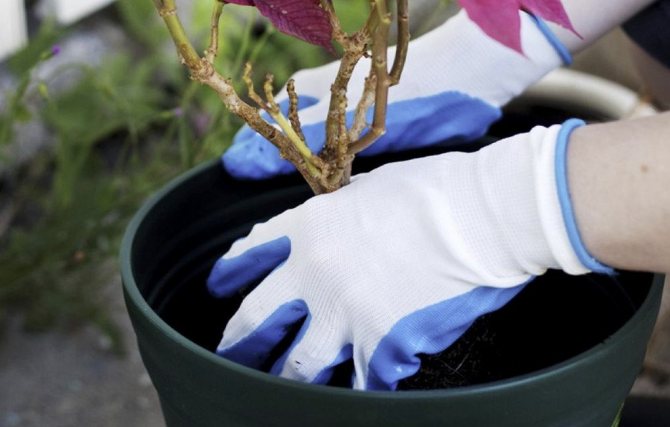

The transplant itself is carried out by transshipment - with the preservation of an earthen coma on the roots. At the same time, the root collar is not buried.
If a purchased plant has sluggish leaves that begin to fall off when the soil is normally moist, then most likely you bought a flower with rotten roots. Such a plant should be transplanted into a new substrate as soon as possible, and when transplanting, examine the root system and remove rotten dead roots. After the procedure, the flower must be poured abundantly with settled water with "Fundazol" and the excess liquid must be drained from the pallet.
To make it easier to survive such a stressful procedure as transplantation, it must be sprayed with "Epin". Then he is placed in a warm and well-lit place. In subsequent years, the bush is transplanted when the roots have already mastered the entire space of the container - once every 2-3 years.
Video: Trimming and replanting poinsettia
How can you propagate poinsettia at home
Reproduction of poinsettia is usually done by cuttings in the spring or even at the very beginning of summer. To do this, you need apical cuttings, namely, sprouts that have at least five internodes. All sections must be dried with special blotting paper and treated with crushed charcoal.
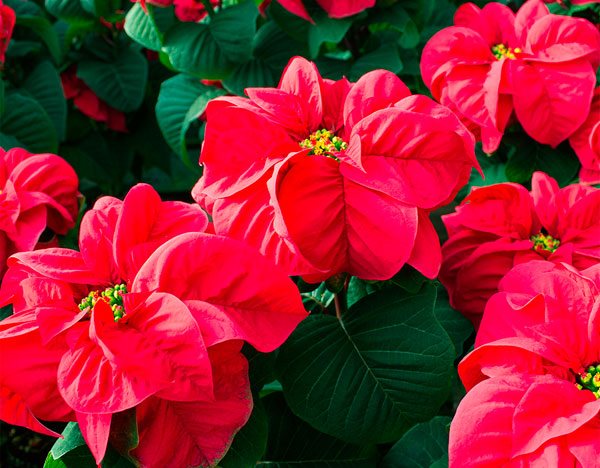

Cut cuttings should be held in warm water to leave the juice, and then process the cut with a root former. Then you can put these cuttings in clean, soft water or plant in a moist and light substrate. Growth stimulants will be useful. Of course, for the reproduction of poinsettia, you can also make a greenhouse, but you have to make sure that the air inside it does not heat up by more than 28 degrees (best of all, 18-21 degrees).
The plant needs to be sprayed frequently and ventilated periodically. Rooting takes a month on average, after which the cuttings that have taken root can be planted in separate pots and kept at the usual 16 degrees of heat. In the fall, grown seedlings can be resettled in larger containers. Keep in mind that plants propagated in this way will bloom only the next year.
Poinsettia seeds do not propagate at home. It is difficult, and even a plant grown from a seed can “forget” all the properties of the “parent” plant grafted by breeders. Therefore, this procedure has no practical meaning.
Poinsettia varieties
The modern era of poinsettia flower cultivation began with the emergence of Oak Leaf seedlings. Currently, dozens of varietal forms are grown for commercial purposes, however, on our sale you can most often see varieties of red poinsettia.
Winter Rose is one of the first terry varieties to be bred with an amazing spherical shape of inflorescences. Available in red, pink, beige and two-tone colors.
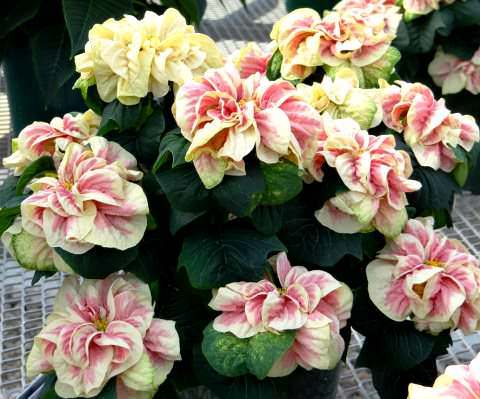

"Premium Miro" is a tall shrub with lush corrugated pink-white bracts.
Peppermint Ruffles. This short and compact variety with leaves in all shades of orange, yellow and pink is a significant improvement on the old form and was introduced to the public in 2017. Belongs to the varietal group "Autumn Leaves".
Gold Rush is another variety of the autumn group with lemon-yellow bracts.
Cinnamon Star This new variety is available in orange-peach and pink foliage.
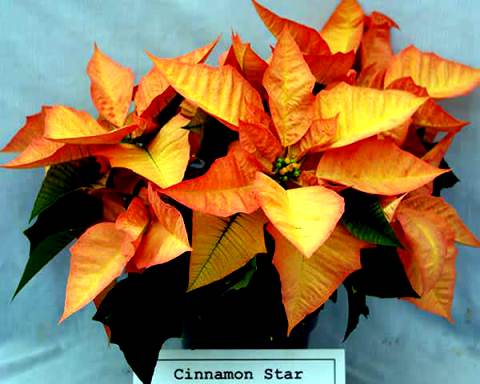

"Christmas Beauty North Pole" with bright golden-lemon leaves.
"Jingle Bell Rock" - bright red leaves around the flowers seem to be strewn with splashes of white spots and strokes.
Tapestry - the red bracts contrast with the decorative lower leaves - they are green with a bright yellow border around the edges.
Diseases and pests affecting poinsettia
Among the most common harmful insects that precipitate poinsettia are mealybugs, whitefly well-known to flower growers, ubiquitous spider mites, and scale insects. You can resist them with the help of chemicals purchased in the store, strictly following the instructions, or alternatively using folk methods. The scale insect and not too numerous aphids will be defeated by a weekly rubbing with soapy water with the organization of a subsequent shower for the plant. Treating the foliage with mineral oil will relieve the bugs.
Poinsettia diseases include gray rot (appears due to high humidity) and powdery mildew (caused by poor sanitary conditions or insect damage). You can effectively fight the scourge with the help of special drugs.
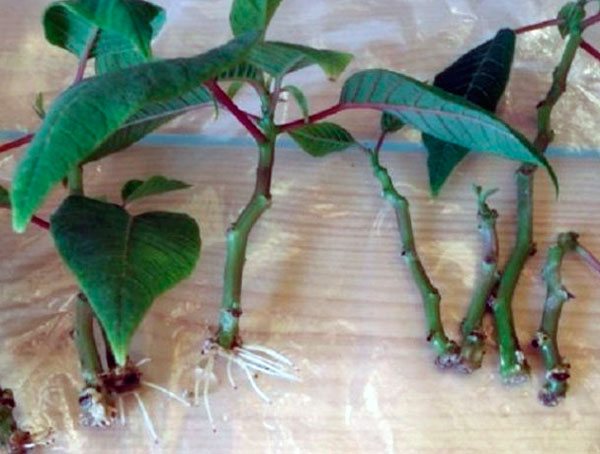

Possible growing difficulties
When maintaining a poinsettia, you can face some difficulties. They are mainly associated with improper care of this indoor flower.
Why does not it bloom
The main problem that can be faced is that poinsettia does not bloom. The following factors are common causes of this phenomenon:
- Violation of the temperature regime. A lower (below 14 ° C) or excessively hot temperature leads to malfunctions in the functioning of the root system, and the plant cannot adapt to changes in any way.
- Bad light. Bright diffused lighting is required.
- Excessive watering. Stagnation of water in the soil negatively affects the development of the flower. Watering should be carried out when the soil in the pot dries up by 2-3 cm.
- Failure to comply with the rules during the rest period.
- Poor quality soil.
- Dry air. In the heat, do not forget to spray with a spray bottle. In the heating season, this problem also appears, therefore, in this case, it is recommended to place a container of water near the flower pot.
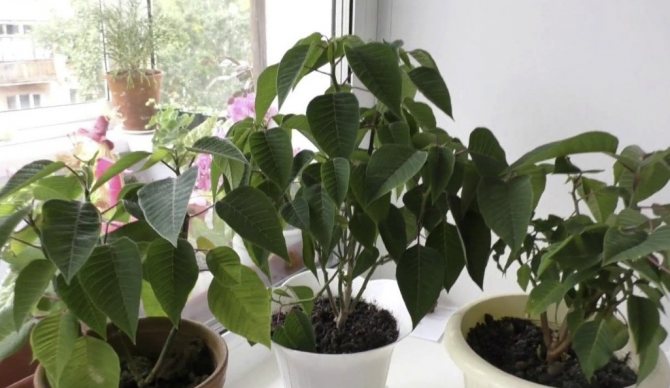

Diseases and pests
Due to excessive watering, the plant can get sick with fungal diseases, and dry air can cause some pests to appear.
This indoor flower can be susceptible to the following diseases:
- Gray rot. Appears due to excess moisture. All damaged areas should be removed and the chemical "Fundazol" should be applied.
- Root rot. Excessive watering is also the cause of this fungal disease. The plant stops developing and dries up, the leaves turn yellow.It is necessary to replace the soil with the removal of the roots damaged by the disease, as well as to carry out the treatment with the preparation "Fitospor".
- Leaf spot. Dark brown moist spots appear on the leaves. This is often due to high humidity. The affected parts of the plant are removed, the soil is replaced and the treatment is carried out 3 times with an interval of 7-10 days with fungicides ("Fitosporin").
- Rust. This fungal disease manifests itself as a rusty coating on the plant. The affected parts are removed and treated with Bordeaux liquid.
- Powdery mildew. A white powdery coating is observed on the poinsettia, which begins to darken over time. Chemical preparations "Fitosporin", "Topaz", "Skor" should be used.
Did you know? In the United States, December 12 is celebrated as National Poinsettia Day. This date is dated not only to the time of flowering of this beautiful plant, but also to the date of death of Joel Poinsett, after whom it is named.
Insect pests can appear on poinsettia:
- Spider mite. Brown spots and a thin cobweb are visible on the plant. The flower is wiped with a sponge dipped in soapy water (you only need to use laundry soap), and chemical preparations are used ("Aktellik", "Aktara").
- Shields. You can identify pests by sticky bloom and yellow-brown blotches on the leaves. In this case, the foliage is treated with soapy water and chemicals are used (Fitoverm, Fufanon).
- Mealybug. This insect is light in color, about 5 mm long. It can be detected by a white bloom that looks like cotton wool. The plant is wiped with soapy water and appropriate chemicals are used (Aktara, Aktofit).
- Aphid. These are small insects with wings. When they appear, the plant slows down growth and development, the leaves turn yellow. They are treated with the preparations "Aktofit", "Fitoverm".
Care errors
- Leaves turn yellow and fall off during the growing season - high air temperature
- Leaves are sluggish - insufficient watering
- Leaves wither and fall - excessive watering
- Leaves dry - low air humidity
- Dark spots at the base of the trunk, the plant staggers - the plant is flooded, root rot is possible. The plant is urgently transplanted into new soil, the root system is examined, damaged roots are removed, the remaining roots are treated with a root rot preparation. The pot for the transplant is treated with laundry soap or a new one is taken.
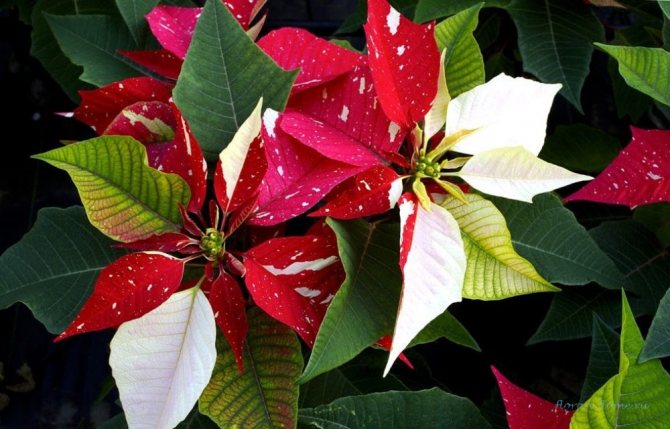

Share link:
Rate the article!
[Total: 1 Average: 5]
What to do after buying a poinsettia
So, the purchase is complete and you, satisfied, bring the poinsettia home. What to do next?
First, choose a well-lit windowsill for her. Keep in mind she does not tolerate drafts! While the poinsettia is acclimatized, create a room temperature for it at 16-17 degrees.
The habituation process will last for about three weeks. After that, transplant it into the ground, after making good drainage, adding sand and vermiculite there.
This video shows you how to care for a plant after purchase, how to prune it, and how to make it bloom next year:
A bit of history
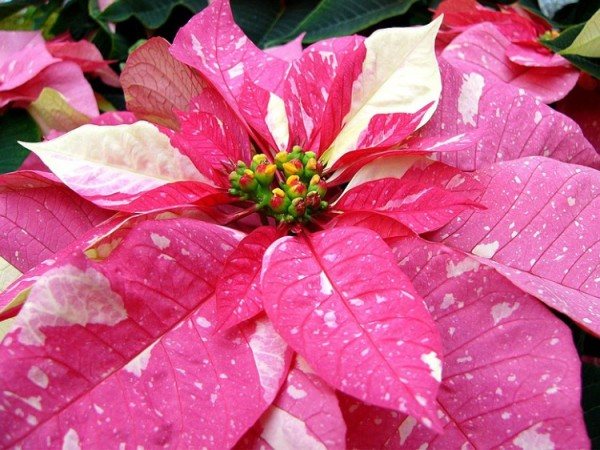

Back in the 17th century, Spanish Franciscan monks living in Mexico noticed that the flower blooms its bright, red bracts around the same time as Catholics celebrate Christmas. Moreover, their attentive eye noted: during flowering, the plant becomes like a scarlet star. "Christmas Star!" - a thought struck the monks, and they began to specially cultivate poinsettia as a decoration for an important holiday. "Buena Night" - the night before Christmas, as the monks called the wondrous flower. And even today it is very often called such nicknames: Christmas flower, Star of Bethlehem ...
The Ecky family from California gave milkweed a real start in life. In the 30s of the XX century, they became interested in a flower that grew in these parts of the "savage". The family remembered a long-standing monastic tradition, began to grow poinsettia flowers in special greenhouses, and offer them to customers for Christmas.
The local people liked the idea, and the family made great efforts to develop new varieties suitable for home floriculture. In parallel, there was a vigorous commercial activity: the plants were sent by mail to other states and even countries. By the 60s, millions of poinsettias were already on sale in the United States; Christmas began to be associated with this particular flower.
But the family kept the intricacies of caring for the plant a secret until the end of the 80s! The Eckies proved to be excellent businessmen and botanists. They have developed many new varieties, and the United States still sells about 60 million poinsettia annually!

